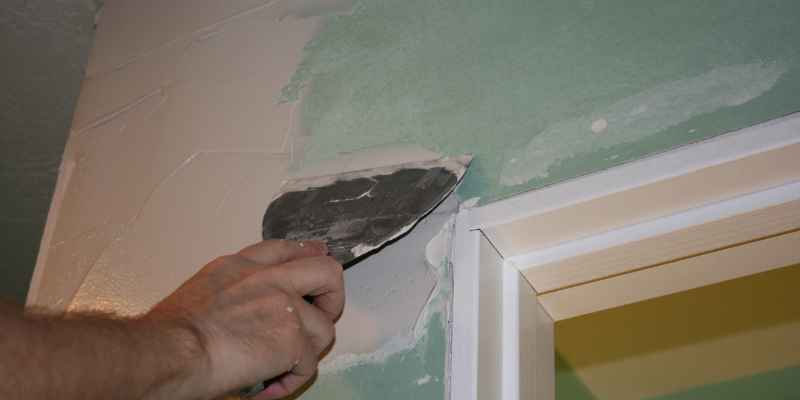Yes, spackle can work on wood for small repairs. Wood filler is a better option for larger gaps and imperfections due to its denser nature, which sands more evenly for a smooth finish.
When it comes to repairing wood surfaces, wood filler is the preferred choice. It effectively fills nail holes and more substantial imperfections before finishing. Spackle, on the other hand, is ideal for filling small holes and cracks in plaster. Both products have distinct properties that make them suitable for specific applications.
Understanding the differences between spackle and wood filler ensures you choose the right product for your woodworking projects.
Differences Between Wood Filler And Spackle
Wood filler and spackle are commonly used to repair imperfections in wood surfaces, but they have distinct differences in terms of their properties and applications. Understanding the disparities between the two will guide you in making the right choice for your specific woodworking needs.
Comparing Wood Filler And Spackle
When comparing wood filler and spackle, it’s important to consider their primary purposes. Wood filler is specifically designed to fill and repair imperfections in wooden surfaces, such as gaps, cracks, and holes, while spackle is commonly used for repairing walls and ceilings. These distinctions in intended use impact their composition and effectiveness when applied to wood surfaces.
Properties Of Wood Filler
- Specifically formulated for wood surfaces
- Composed of wood particles and a binding agent
- Dries to a hard, durable finish
- Ideal for filling larger gaps and voids in wood
- Sands easily for a smooth and seamless appearance
Properties Of Spackle
- Mainly used for repairing walls and ceilings
- Comprised of gypsum or other fillers mixed with a binder
- Dries quickly to a hard, paintable surface
- Best suited for small repairs and surface imperfections
- May not provide the same level of durability on wooden surfaces as wood filler
Using Spackle On Wood
Using Spackle on wood is not recommended as it is primarily designed for repairing holes and cracks in plaster. For wood repairs, it is best to use wood filler, which is specifically formulated to fill imperfections in wood surfaces.
When To Use Spackle On Wood
Spackle on wood is ideal for repairing small imperfections, such as scratches, holes, or dents in wooden surfaces.
Benefits Of Using Spackle On Wood
- Efficiently fills in minor damages on wood surfaces.
- Dries quickly, allowing for prompt sanding and painting.
- Leaves a smooth finish making the repair virtually invisible.
Limitations Of Spackle On Wood
- Not suitable for large or deep repairs on wood.
- May not withstand heavy stress or pressure once dried.
- Does not blend well with natural wood colors without painting.
Applying Spackle On Different Wood Surfaces
When it comes to wood surfaces, Spackle can be used to repair holes and cracks. It is a versatile compound that can be applied to both painted and unpainted wood, providing a smooth and durable finish.
Using Spackle On Painted Wood
When it comes to repairing imperfections on painted wood surfaces, spackle can come in handy. Whether you’re dealing with nail holes, dents, or minor damage, spackle allows you to quickly and easily fill in these flaws. Its smooth texture and easy application make it the perfect solution for restoring the pristine appearance of painted wood.
Spackle For Wooden Furniture
Wooden furniture is susceptible to wear and tear over time. Scratches, gouges, and other blemishes can detract from the beauty of your favorite pieces. Fortunately, spackle can be a game-changer when it comes to rejuvenating wooden furniture. Simply apply a small amount of spackle to the damaged area, smooth it out with a putty knife, and let it dry. With a little sanding and a fresh coat of finish, your furniture will look brand new again.
Spackle For Wood Floors
Wood floors are prone to nicks, scratches, and small holes, especially in high-traffic areas. Spackle can be an excellent solution for addressing these imperfections. Just fill in the gaps or damaged areas with spackle, ensuring it is level with the surrounding floor. Once it has dried, use sandpaper to smooth it out and blend it seamlessly. Remember to match the spackle color to your floor finish, so the repairs are barely noticeable.
With a basic understanding of how to use spackle on different wood surfaces, you can now take on those DIY repairs with confidence. Whether it’s painted wood, wooden furniture, or wood floors, spackle is a versatile and effective tool for restoring the beauty and integrity of your wooden surfaces.
Alternative Wood Repair Options
Alternative wood repair options, such as wood filler, are more suitable for fixing wood surfaces compared to using spackle, which is commonly used for walls and ceilings. Wood putty, a combination of wood dust and binder, is recommended for filling imperfections in wood before finishing.
Choosing the right repair material is crucial for optimal results in woodworking projects.
Exploring Wood Putty For Wood Repairs
When it comes to repairing wood, one alternative to spackle is wood putty. Wood putty, also known as plastic wood, is a versatile substance used to fill imperfections in wood surfaces before finishing. It is made by combining wood dust with a binder, thinner, and sometimes pigment. Wood putty provides a durable and long-lasting solution for addressing nail holes, gouges, and other blemishes in wood.
Caulk As An Alternative To Spackle
Another alternative to spackle for wood repairs is caulk. While traditionally used for sealing gaps and joints in construction, caulks can also be used to repair minor wood damage. Caulk is a flexible and waterproof material that can be easily applied and shaped to fill cracks, splits, and small holes in wood.
Comparing Spackle, Wood Filler, And Wood Putty
| Feature | Spackle | Wood Filler | Wood Putty |
|---|---|---|---|
| Uses | Spackle is primarily used for repairing walls and ceilings. | Wood filler is specifically designed for repairing wood surfaces. | Wood putty is used for filling imperfections in wood prior to finishing. |
| Composition | Spackle is typically made from gypsum or calcium carbonate. | Wood filler is composed of wood fiber and a binding agent. | Wood putty is a mixture of wood dust, a binder, a thinner, and sometimes pigment. |
| Durability | Spackle is less durable and may crack or crumble over time. | Wood filler provides a more stable and long-lasting repair. | Wood putty offers excellent durability and is resistant to cracking or flaking. |
Each of these options has its own merits and is better suited for specific applications. Spackle is ideal for repairing walls and ceilings, while wood filler and wood putty are tailored for wood surface repairs. It is important to choose the right product based on the nature and extent of the wood damage.
Whether you opt for wood putty, caulk, or another alternative, it’s essential to follow proper application techniques and allow sufficient drying time for the material to set. By considering the available options, you can find the best solution for your wood repair needs.
Best Practices For Wood Repairs
If you’re considering using spackle on wood surfaces for repairs, it’s essential to follow the best practices to ensure a successful outcome. When it comes to wood repairs, understanding the proper techniques is crucial. Let’s delve into the best practices for wood repairs, focusing on filling gaps and holes in wood, and sanding and finishing the repaired areas.
Filling Gaps And Holes In Wood
- Inspect the wood surface carefully to identify any gaps or holes that need to be filled.
- Choose a high-quality wood filler or spackling compound suitable for wood repairs.
- Apply the filler generously to fill the gaps and holes, ensuring a smooth and even finish.
- Allow the filler to dry completely before proceeding to sanding and finishing.
Sanding And Finishing Wood Repairs
- Use fine-grit sandpaper to smooth the repaired area and blend it seamlessly with the surrounding wood.
- Ensure the surface is free of any rough patches or uneven areas before proceeding to finishing.
- Apply a suitable wood finish or paint to match the existing wood color and texture for a cohesive look.
- Allow the finish to dry completely as per the manufacturer’s instructions.
By following these best practices for wood repairs, you can effectively use spackle on wood surfaces to restore and enhance the appearance of your wooden items. Remember to choose the right products and techniques to achieve professional results.
Common Questions About Using Spackle On Wood
Spackle can be a versatile solution for DIY wood projects. From filling small nail holes to repairing minor imperfections, spackle can be an efficient choice for wood surfaces.
Comparing spackle with other fillers for wood, spackle is easy to apply and sand, making it ideal for smaller holes and seams. However, for larger gaps or outdoor projects, consider using wood putty or wood filler for better durability.

Frequently Asked Questions Of Does Spackle Work On Wood
Can You Use Drywall Spackle On Wood?
Yes, you can use drywall spackle on wood for small repairs and filling holes. It can be painted over for a smooth finish.
What Is The Difference Between Wood Putty And Spackle?
Wood putty is for filling imperfections in wood, while spackle is for repairing walls and ceilings.
Can I Use Drydex Spackling As Wood Filler?
Yes, you can use DAP DRYDex Spackling as wood filler to fill holes and cracks in various surfaces including wood.
How Do You Fill Big Gaps In Wood?
To fill big gaps in wood, use wood filler instead of spackle. Wood filler is specifically designed for repairing and filling imperfections in wood surfaces. It is denser and sands more evenly with the wood, resulting in a smoother finish.
Conclusion
When deciding between wood filler and spackle for wood repairs, consider their unique properties. Choose wood filler for wood surfaces and spackle for walls and ceilings based on application needs. Understanding their differences ensures effective use of each product. Make informed choices for seamless repairs.


